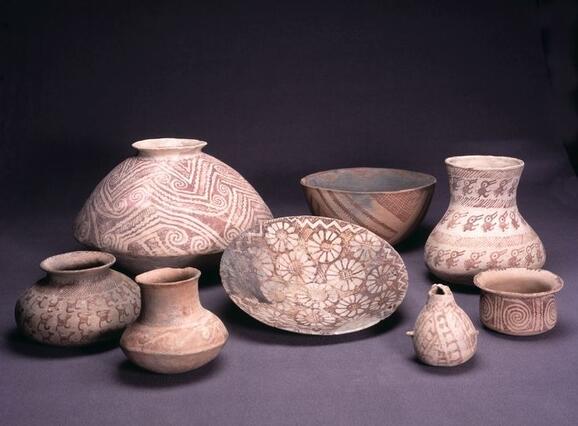By Ana A. Gonzalez
Spring 2020
Europeans first arrived in present-day America in the sixteenth century. They weren’t the first settlers, however. In what is known today as Arizona, they found Native American communities who were thriving on hunting, farming, and advanced trade networks. In what is today’s central Arizona (home to Phoenix), Europeans did not find living humans, only proof of previous settlements and migration. Many signs, artifacts, and remains made it apparent that human life once prospered in the Salt River Valley.

If you were raised in Phoenix, or traveled to Arizona, there is a great chance that you’ve heard about an ancient group of people called Hohokam. They were the first settlers in Arizona. The name Hohokam is interpreted to mean “those who have vanished” or “those who have gone.” Scholars decided on this name since they could not explain the gap of one hundred years of archaeological record and thus decided they simply disappeared or vanished.
Many historians and archaeologists have researched their disappearance, but still to this day, no one can explain with validity what happened to the Hohokam people. The Hohokam are thought to have been around between 300 B.C. and 1 A.D. and left around 1200 A.D. It is believed they migrated north from Tucson, Arizona to south-central Phoenix, Arizona. They were known to inhabit South Mountain, which is in close proximity to both the Salt River and Gila River. Historians and archaeologists believe that this area first attracted the Hohokam because it was “cooler, and with greater diversity of creatures than the river basins, the South Mountains would have been an attractive place to visit for ancient desert farmers.” Thus the Hohokam gave life to this area, making it “the most populous and agricultural productive valley in the West before 1500 CE” (Bostwick, Todd, archaeologist).

The Hohokam were able to survive and transform a dusty desert into great farmland by what they are most known for: irrigation canals and ditches. These irrigation canals stretched as far as ten miles from a river’s point of origin to the next village. The canals were dug up with wood and stone and were “ten feet deep and thirty feet wide… [and] major prehistoric canals account for about three hundred miles and nearly nine hundred miles of smaller ones within the lower Salt River Valley” (The Short Swift Time of Gods on Earth, 1994).

(Source: Southwest Parks and Monuments Association)
Because Hohokam territory was so extensive, it is suspected they adopted new
culture along the way. An indication of that is, how they changed from cremating their dead to burying the body entirely underground. An unresolved suspicion is their disappearance. There is not much to note on their abrupt decline other than mentioning their sudden vanishing happened around the same time the Europeans arrived.
Several tribes do not accept the Hohokam to have vanished. Interestingly
enough, the Akimel O’odham/Pima and the Tohono O’odham/Papago tribes believe to be direct descendants of the Hohokam. The Gila River Indian Community have alternatively named them Huhugam meaning “loved ones who have passed.” Other tribes such as: Hopi, Zuni, and Yuma also have cultural material which is evident of the Hohokam.
Though there are controversies as to what happened to the Hohokam or
Huhugam, they will forever be credited for their advanced skills in farming and the birth of irrigation canals. To this day there are Hohokam ruins/homes and parts of villages that can be seen in museums around Arizona.
Bibliography
- “Origin of Irrigation.” The Short, Swift Time of Gods on Earth: the Hohokam Chronicles, by Donald M. Bahr, University of California Press, 1994.
- “Early Settlements in South Phoenix: The Myth of the Vanished,” by Summer Cherland, 2020.
- Reynolds, S.J., 1985, Geology of the South Mountains, Central Arizona. Arizona
- Geological Survey Bulletin-195, 75 p., 1 map plate, scale 1:24,000. http://repository.azgs.az.gov/uri_gin/azgs/dlio/1655. Accessed 4/29/2020.
- Hill, J. Brett. From Huhugam to Hohokam: Heritage and Archaeology in the American Southwest. (Lanham, MD: Lexington Books, The Rowman & Littlefield Publishing Group, Inc., 2019).
- Bostwick, Todd W., Landscape of the Spirits: Hohokam Rock Art at South Mountain Park, (Tucson, AZ: University of Arizona Press, 2002): 2.
- Wells, E. Christian. From Hohokam to O’odham: The Protohistoric Occupation of the Middle Gila River Valley, Central Arizona. Gila River Indian Community Anthropological Research Papers, No. 3. (Sacaton, AZ: Gila River Indian Community, Cultural Resource Management Program.)
- Doyle, David E. “Hohokam Cultural Evolution in the Phoenix Basin.” In Exploring the Hohokam: Prehistoric Desert Peoples of the American Southwest, ed. George J. Gumerman. (Albuquerque, NM: University of New Mexico Press). Estimates of Hohokam prominence are complex and inconclusive. Some believe the Hohokam disappeared around 1AD. More recent estimates cite archaeological evidence placing their “collapse” around the height of the Classical Period, about 1450 AD.
- McClelland, John A. “Revisiting Hohokam Paleodemography.” American Antiquity, vol. 80 , no. 3, 2015, pp. 492–510.
- Howard, Jerry B. “Hohokam Legacy: Desert Canals.” WaterHistory.org, http://www.waterhistory.org/histories/hohokam2/ .
- “Hohokam Indian Ruins – Picture of Phoenix, Central Arizona.” Tripadvisor, http://www.tripadvisor.com/LocationPhotoDirectLink-g31310-i24237002-Phoenix_Arizona.html.
- Nextdoor. “Jan 27 · Hohokam Pottery Demonstration – Fort Lowell Museum – Nextdoor.” Nextdoor.com , 27 Jan. 2018., nextdoor.com/events/az/tucson/hohokam-pottery-demonstration-fort-lowell-museum-1819231.

